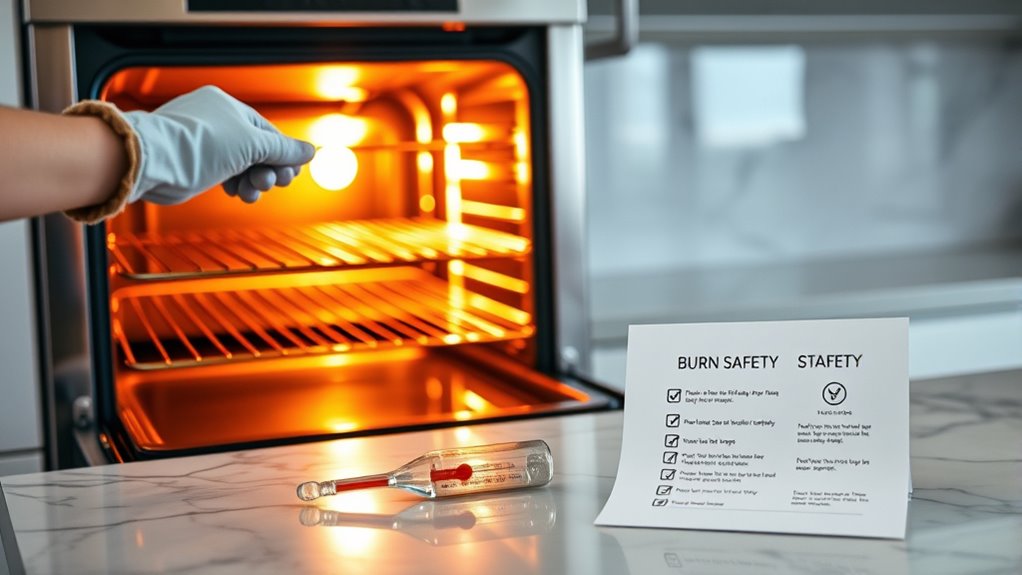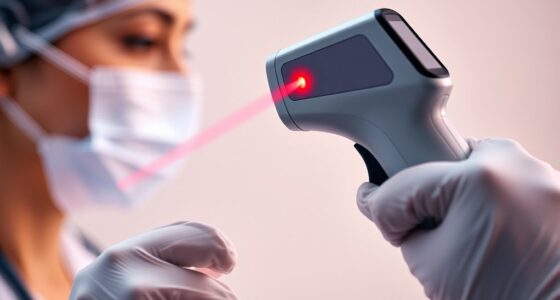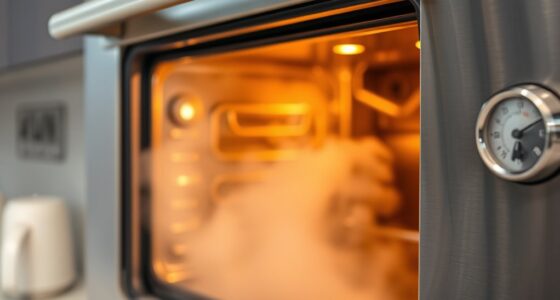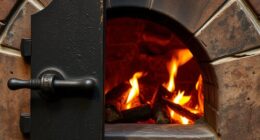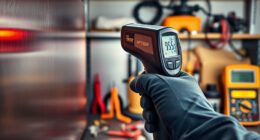Before you start, make certain your oven safety is top priority. Always wear properly fitting oven mitts when handling hot dishes and keep your workspace clear to avoid accidental spills or knocks. Check that your smoke detectors work and stay attentive during oven use. Take your time when removing hot items, using controlled movements to prevent burns. Following these essential precautions helps keep you safe — continue for more tips and safety tips to reduce your risk.
Key Takeaways
- Always wear properly fitting oven mitts or gloves before handling hot oven items.
- Check that smoke detectors are functional and within easy reach in the kitchen area.
- Keep your workspace clear of clutter to prevent accidental spills or knocks during oven use.
- Open oven doors slowly to release steam and avoid burns from hot vapors.
- Follow established safety procedures and stay attentive to minimize burn risks around hot ovens.
Common Causes of Oven-Related Burns and How to Prevent Them
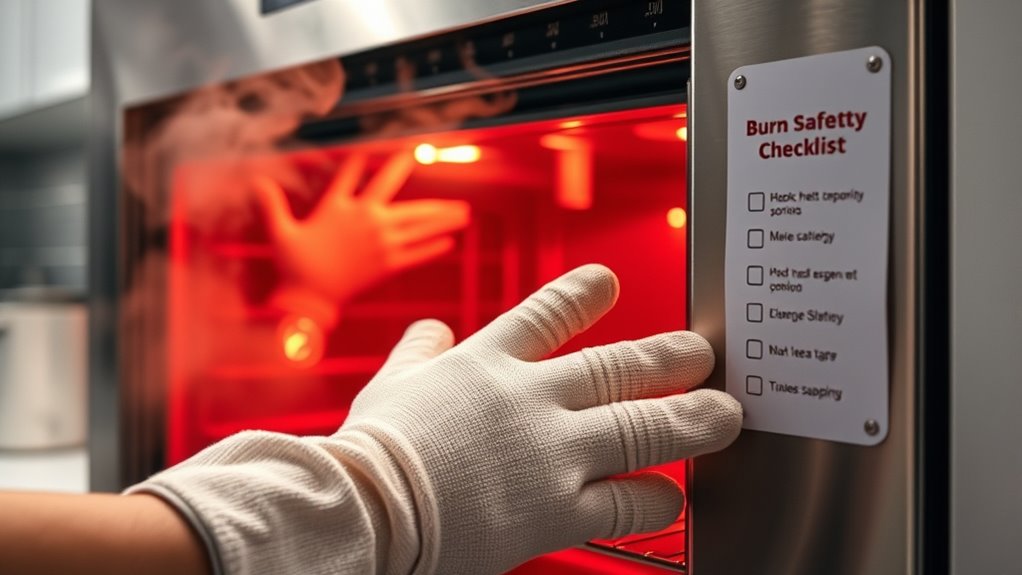
Many oven-related burns happen because people underestimate the risks or get careless while handling hot surfaces. A common mistake is not using oven mitts, which leaves your hands vulnerable to burns when retrieving hot dishes or racks. Always wear sturdy oven mitts or gloves to protect your skin from direct heat. Additionally, neglecting to check smoke detectors can lead to dangerous situations if a fire or smoke develops from oven mishaps. Keep smoke detectors functional and nearby, so you’re alerted early to any danger. Rushing or reaching over hot surfaces without caution also increases burn risk. Staying attentive, using proper oven mitts, and ensuring smoke detectors are working are simple but essential steps in preventing oven-related burns. Proper oven safety procedures can further reduce the likelihood of accidents and injuries.
Essential Safety Gear and Precautions When Handling Hot Ovens

Handling hot ovens requires you to prioritize safety by using the right protective gear and following vital precautions. Always wear sturdy oven mitts to protect your hands from burns when handling hot dishes or opening the oven door. Safety glasses are essential to shield your eyes from steam, splatters, or unexpected sparks. Keep a clear workspace free of clutter to avoid accidental spills or knocks. Use oven mitts even when adjusting racks or reaching inside, and never rush during high-heat tasks. Additionally, confirm your protective gear fits properly for maximum safety. Remember, proper gear minimizes injury risk and keeps you in control when working around hot ovens. Being cautious with your equipment is key to a safe cooking environment.
Tips for Safe Removal and Handling of Hot Items From the Oven

After guaranteeing you’re wearing the proper protective gear, it’s important to focus on safely removing hot items from the oven. Always use sturdy oven mitts to grip pans securely, preventing slips that can cause burns. When lifting hot dishes, keep your movements slow and controlled to avoid spills. Once out of the oven, place the hot item on a cooling rack to prevent heat transfer to countertops and to allow even cooling. Be mindful of the steam that may escape when opening lids or foil, and keep your face and hands away from steam vents. Never rush the process—rushing increases the risk of accidents. Taking these precautions helps ensure your safety while handling hot oven items efficiently and confidently. Additionally, being aware of your surrounding kitchen environment can help prevent accidents caused by clutter or distractions.
Frequently Asked Questions
How Often Should I Replace Oven Mitts for Safety?
You should replace your oven mitts every 6 to 12 months, depending on their oven mitt durability and how often you use them. Over time, heat resistant materials can wear out, reducing their effectiveness. Check for signs of damage like thinning, tears, or loss of flexibility. If you notice any of these, it’s time to get new mitts to guarantee your safety when handling hot items.
Can Children Be Safely Around Hot Ovens?
Children can be around hot ovens if you supervise them closely and maintain oven door safety. Keep kids at a safe distance, especially when the oven is in use, and never leave them unattended near hot appliances. Always supervise their activities in the kitchen, and make sure oven doors are securely closed to prevent accidental burns. Your vigilance guarantees their safety while allowing them to learn and help in the kitchen responsibly.
What Are Signs of Oven-Related Burns Needing Medical Attention?
If you notice oven burn symptoms like intense pain, blistering, swelling, or skin discoloration, seek emergency treatment immediately. These signs indicate a serious burn that could need professional care. Don’t try to treat severe oven burns at home; instead, keep the area clean, cover it with a sterile bandage, and go to the emergency room. Prompt medical attention helps prevent complications and promotes proper healing.
Are There Specific Oven Safety Tips for Seniors?
Oven safety for seniors is like guiding a gentle hand; you need to stay cautious. Keep oven controls simple, use oven mitts, and never leave it unattended. Installing stove knobs with easy-to-turn features and keeping a clear area around the oven helps prevent accidents. Follow senior precautions by checking for proper lighting and ensuring handles are turned inward. These steps make your kitchen safer and more manageable.
How Do I Safely Dispose of Oven Cleaning Chemicals?
To safely dispose of oven cleaning chemicals, you should first read the label for specific disposal methods, as chemical hazards vary. Wear gloves and eye protection to prevent contact. Do not pour chemicals down the drain or into regular trash unless instructed. Instead, take them to a designated hazardous waste disposal site or follow local regulations. Proper disposal minimizes risks to people and the environment.
Conclusion
Remember, safety around hot ovens isn’t just about avoiding burns—it’s about protecting your home and loved ones, like a guardian watching over a precious treasure. By staying alert, using proper gear, and following these tips, you can prevent accidents before they happen. Think of it as your personal shield, turning everyday cooking into a safe, worry-free experience. Keep safety at the forefront, and your kitchen will remain a place of warmth and joy.
